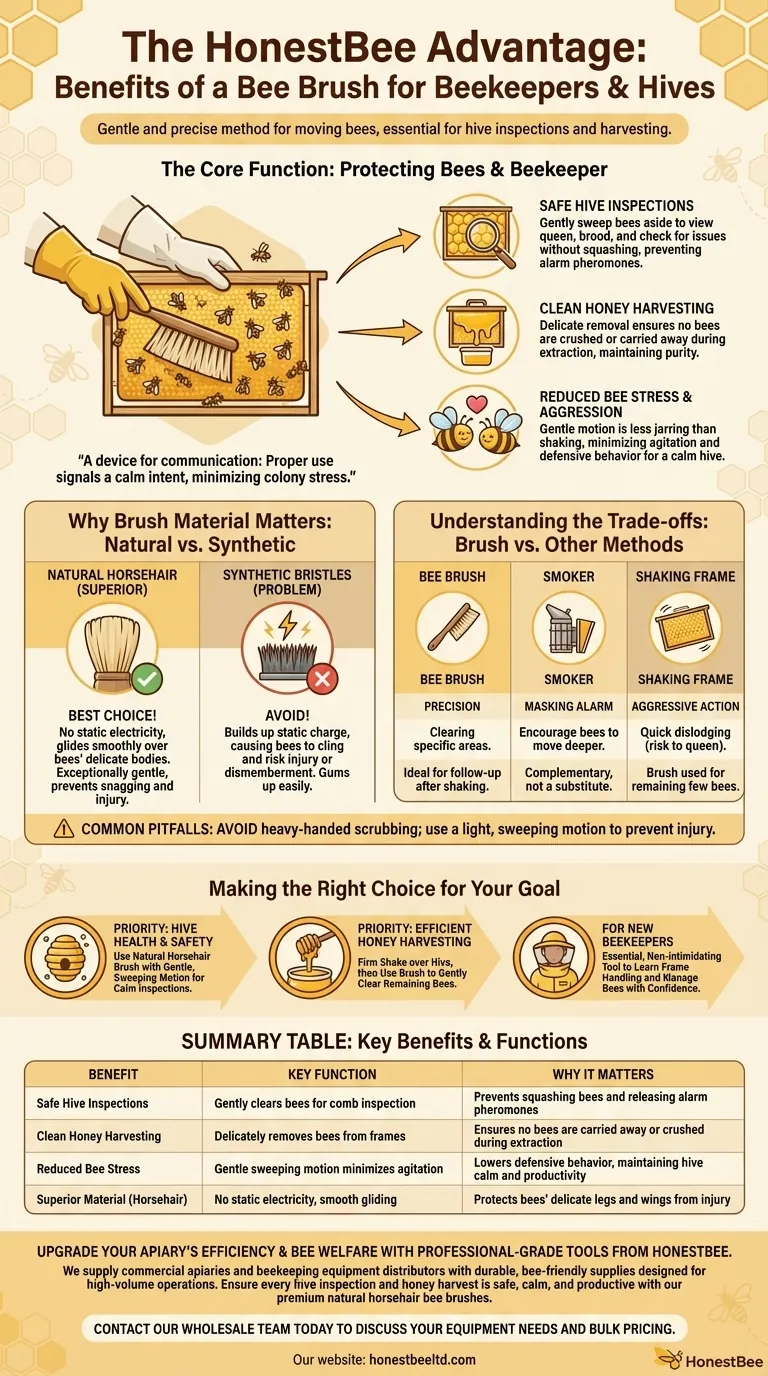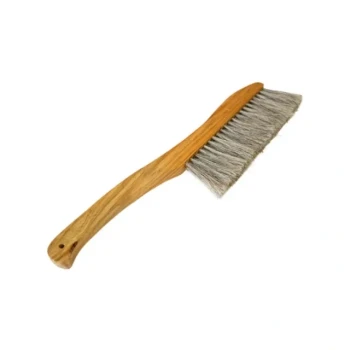The primary benefit of a bee brush is to provide beekeepers with a gentle and precise method for moving bees off a honeycomb frame. This simple tool is essential for performing hive inspections and harvesting honey without harming individual bees or triggering a defensive response from the colony. Its use helps maintain a calm hive environment, which is crucial for both the beekeeper's safety and the bees' well-being.
A bee brush is more than just a tool for moving bees; it is a device for communication. Its proper use signals a calm intent, minimizing colony stress and preventing the chain reaction of alarm and aggression that can disrupt hive productivity for hours.

The Core Function: Protecting Bees and Beekeeper
A bee brush's value comes from its ability to solve the fundamental challenge of beekeeping: needing to handle frames that are covered in thousands of fragile, living insects.
Enabling Safe Hive Inspections
During a hive inspection, you need a clear view of the comb. A brush allows you to gently sweep bees aside to check for the queen, evaluate the brood pattern, and look for signs of pests or disease without squashing bees, which can release alarm pheromones.
Facilitating Clean Honey Harvesting
When removing frames full of honey, they must be cleared of bees before being taken away for extraction. A brush is the most delicate way to ensure no bees are carried away from the hive or crushed in the process.
Reducing Bee Stress and Aggression
A gentle sweeping motion is far less jarring to the colony than shaking or bumping the frames. By minimizing agitation, you reduce the likelihood of bees becoming defensive, making the entire experience safer and more pleasant.
Why the Right Brush Material Matters
Not all brushes are created equal. The material of the bristles has a direct impact on the bees and the effectiveness of the tool.
The Problem with Synthetic Bristles
Many synthetic materials, like nylon or plastic, can build up static electricity. This static charge can cause a bee's delicate legs or wings to cling to the brush, potentially leading to injury or dismemberment. Synthetic bristles also tend to get gummed up with honey and propolis more easily.
The Advantage of Natural Horsehair
The best bee brushes use long, soft bristles made from natural horsehair. This material does not generate static electricity, allowing it to glide smoothly over the bees' bodies without snagging them. It is exceptionally gentle and effective.
Understanding the Trade-offs: Brush vs. Other Methods
A brush is one of several tools for moving bees, and it's most effective when its specific purpose is understood.
Compared to a Smoker
A smoker is used to mask alarm pheromones and encourage bees to move deeper into the hive or away from the top bars. A brush, in contrast, offers precision for clearing a specific frame you are actively holding. They are complementary tools, not substitutes.
Compared to Shaking the Frame
A sharp, downward shake can dislodge the majority of bees from a frame quickly. However, this is an aggressive action that can anger the colony and risks dislodging or injuring the queen if she is on that frame. A brush is the gentle follow-up to remove the bees that cling on after a shake.
Common Pitfalls to Avoid
The biggest mistake is using the brush too aggressively. It is meant for a light, sweeping motion, not a scrubbing one. A heavy hand will injure bees and provoke the defensive response you are trying to avoid.
Making the Right Choice for Your Goal
Ultimately, the bee brush is a tool for fostering a respectful and productive relationship with your bees.
- If your primary focus is hive health and safety: Choose a natural horsehair brush and use a gentle, sweeping motion to conduct calm and thorough inspections.
- If your primary focus is efficient honey harvesting: Use a firm shake over the hive to remove most bees, then use the brush to gently clear the remaining few from the honey frames.
- If you are a new beekeeper: A bee brush is an essential, non-intimidating tool for learning how to handle frames and manage your bees with confidence.
Using the right tool correctly demonstrates respect for the colony and is a cornerstone of sustainable and successful beekeeping.
Summary Table:
| Benefit | Key Function | Why It Matters |
|---|---|---|
| Safe Hive Inspections | Gently clears bees for comb inspection | Prevents squashing bees and releasing alarm pheromones |
| Clean Honey Harvesting | Delicately removes bees from frames | Ensures no bees are carried away or crushed during extraction |
| Reduced Bee Stress | Gentle sweeping motion minimizes agitation | Lowers defensive behavior, maintaining hive calm and productivity |
| Superior Material (Horsehair) | No static electricity, smooth gliding | Protects bees' delicate legs and wings from injury |
Upgrade your apiary's efficiency and bee welfare with professional-grade tools from HONESTBEE.
We supply commercial apiaries and beekeeping equipment distributors with durable, bee-friendly supplies designed for high-volume operations. Ensure every hive inspection and honey harvest is safe, calm, and productive with our premium natural horsehair bee brushes.
Contact our wholesale team today to discuss your equipment needs and bulk pricing.
Visual Guide

Related Products
- Premium Triple-Row Horsehair Bee Brush
- Wooden Bee Brush with Triple Row Artificial Fiber for Beekeeping
- Classic Wooden Bee Brush with Double-Row Boar Bristles
- Double Row Artificial Fiber Bee Brush for Beekeeping
- Wooden Bee Brush with Double-Row Horsehair Bristles
People Also Ask
- What is the purpose of a bee brush? Master Gentle Hive Management for Healthier Bees
- What is a bee brush and what is its primary use? A Gentle Tool for Hive Management
- What is a Bee Brush and how is it used? Master Gentle Bee Handling for Your Apiary
- Why is a bee brush important? Essential for Gentle, Safe Hive Management
- What are the characteristics of the bristles on a bee brush? Designed for Gentle Persuasion, Not Force



















